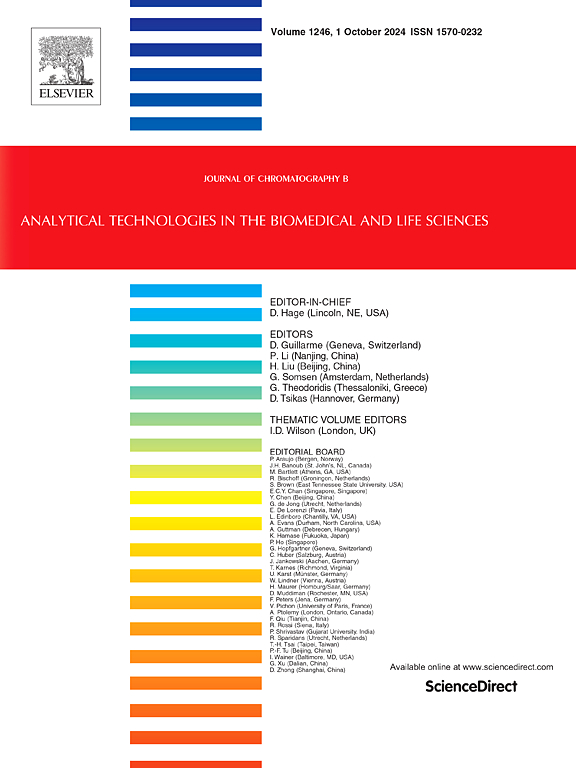Machine learning and chemometric methods for high-throughput authentication of 53 Root and Rhizome Chinese Herbal using ATR-FTIR fingerprints
IF 2.8
3区 医学
Q2 BIOCHEMICAL RESEARCH METHODS
引用次数: 0
Abstract
To address the identification challenges caused by morphological similarities in Root and Rhizome Chinese Herbal (RRCH), this study developed a discrimination system integrating Attenuated Total Reflectance Fourier Transform Infrared Spectroscopy (ATR-FTIR) with multimodal machine learning. 53 kinds of RRCH collected from China were analyzed using ATR-FTIR to acquire spectral fingerprints. An innovative analytical framework was established, combining chemometric Partial Least Squares Discriminant Analysis (PLS-DA) with optimized machine learning models: t-distributed Stochastic Neighbor Embedding (t-SNE), optimized decision trees, optimized discriminant analysis, naive Bayes, optimized SVM, optimized KNN, SVM kernels, and optimized ensemble learning. Multivariate analysis revealed distinct spatial distribution patterns of chemical characteristics among the 53 RRCH species. t-SNE projections demonstrated significant cluster separation in two-dimensional feature space, confirming strong correlations between spectral fingerprints and phytochemical compositions. The SVM model outperformed others, achieving 100 % classification accuracy on both training and validation sets, with a markedly shorter identification time compared to PLS-DA. This ATR-FTIR-machine learning hybrid system enables high-throughput authentication of RRCH and establishes a scalable technical framework for herbal quality standardization. The methodology provides critical insights into chemical marker discovery through vibrational spectrum-feature relationship mapping, advancing intelligent discrimination of botanically similar medicinal materials.
基于ATR-FTIR指纹图谱的53种根茎类中草药高通量鉴别的机器学习和化学计量学方法
为了解决根茎中草药(RRCH)的形态相似性带来的识别挑战,本研究开发了一种将衰减全反射傅立叶变换红外光谱(ATR-FTIR)与多模态机器学习相结合的识别系统。采用ATR-FTIR技术对国内采集的53种RRCH进行了光谱指纹分析。建立了一个创新的分析框架,将化学计量偏最小二乘判别分析(PLS-DA)与优化的机器学习模型相结合:t分布随机邻居嵌入(t-SNE)、优化决策树、优化判别分析、朴素贝叶斯、优化支持向量机、优化KNN、支持向量机核和优化集成学习。多变量分析表明,53种植物的化学特征具有明显的空间分布规律。t-SNE投影在二维特征空间中表现出明显的聚类分离,证实了光谱指纹图谱与植物化学成分之间的强相关性。SVM模型优于其他模型,在训练集和验证集上都实现了100%的分类准确率,与PLS-DA相比,识别时间明显缩短。该atr - ftir -机器学习混合系统实现了RRCH的高通量认证,并为草药质量标准化建立了可扩展的技术框架。该方法通过振动光谱特征关系映射为化学标记发现提供了关键见解,促进了植物相似药材的智能鉴别。
本文章由计算机程序翻译,如有差异,请以英文原文为准。
求助全文
约1分钟内获得全文
求助全文
来源期刊

Journal of Chromatography B
医学-分析化学
CiteScore
5.60
自引率
3.30%
发文量
306
审稿时长
44 days
期刊介绍:
The Journal of Chromatography B publishes papers on developments in separation science relevant to biology and biomedical research including both fundamental advances and applications. Analytical techniques which may be considered include the various facets of chromatography, electrophoresis and related methods, affinity and immunoaffinity-based methodologies, hyphenated and other multi-dimensional techniques, and microanalytical approaches. The journal also considers articles reporting developments in sample preparation, detection techniques including mass spectrometry, and data handling and analysis.
Developments related to preparative separations for the isolation and purification of components of biological systems may be published, including chromatographic and electrophoretic methods, affinity separations, field flow fractionation and other preparative approaches.
Applications to the analysis of biological systems and samples will be considered when the analytical science contains a significant element of novelty, e.g. a new approach to the separation of a compound, novel combination of analytical techniques, or significantly improved analytical performance.
 求助内容:
求助内容: 应助结果提醒方式:
应助结果提醒方式:


